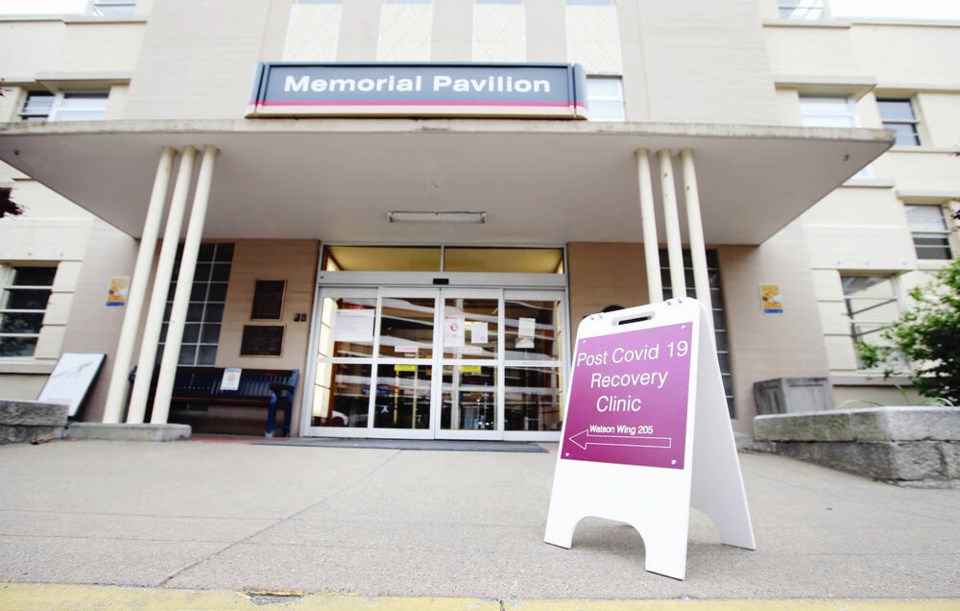Demand for long-COVID treatment is growing with each wave of the pandemic and the five clinics created in B.C. so far are likely not enough, says a retired Vancouver ER physician who hosted a recent briefing on the impact of long COVID.
“We are really going to have a pandemic after the pandemic, because the number of people affected by long COVID is growing with every single wave and is becoming so prevalent that we cannot ignore it,” said Dr. Lyne Filiatrault, who argues more long-COVID clinics are needed to meet current and future demand.
Filiatrault spoke about complications including heart attack, stroke and blood clots following COVID infection, at the event sponsored by Protect Our Province B.C., a group made up of doctors, nurses and health experts advocating evidence-based health policies.
Referrals to the Post COVID Recovery Clinic at Royal Jubilee Hospital — the fifth such clinic in the province when it opened in March — have already more than doubled to 152 from 60, according to Island Health.
Patients for the Victoria clinic must be three months past their initial COVID symptoms and be referred by a physician or nurse practitioner.
Health Minister Adrian Dix said more is known about COVID and long COVID every day, and B.C. is moving “more quickly than anywhere else,” having set up a long COVID network for health-care providers across the province.
The Post-COVID-19 Interdisciplinary Clinical Care Network says its aim is to support the best possible outcomes for people recovering from lingering symptoms after COVID-19 infection, through research, education and care.
The network, a partnership of the Provincial Health Services Authority, the province’s health authorities, patients and research organizations, offers interdisciplinary clinics, supports for primary-care providers and resources to help those affected manage their symptoms.
“It’s never just going to be clinics — you’re going to have to have a network of providers everywhere in the province who know what to do,” said Dix. “That’s why we put our network in place first, linking together all of our health authorities. The five clumps are just one aspect of that.”
Filiatrault said with a lack of data around long COVID, it’s difficult to know the size of the problem.
“We’re two years into this and I can’t tell you the number of patients in British Columbia with long COVID. We don’t know how many patients acquired COVID after the last wave. We don’t know what the wait times are across the province for long-COVID clinics,” said Filiatrault. “We need data.”
Dix said data collected by the province on long COVID will be made public. Research from around the globe has to be in the hands of clinicians if they are to effectively respond to this new chronic disease, he said.
Dr. Neeja Bakshi, an internal medicine specialist in Edmonton who has cared for acute COVID cases during the first two years of the pandemic, opened a long-COVID clinic in January and said referrals have “gone through the roof,” with a three-to-four-month backlog.
Initially thought to just be a respiratory disease, COVID-19 was soon discovered to be a systemic inflammatory disease, affecting not only the lungs but many other areas and organs of the body, she said. And just as COVID can affect every system in the body, so can long COVID or complications from the virus.
Long COVID is defined generally by symptoms of the virus that don’t go away after eight to 12 weeks, said Bakshi.
The World Health Organization and Centres for Disease Control and Prevention list more than 200 symptoms, but Bakshi said commonly seen ones include fatigue, fever, chest pain, shortness of breath, tachycardia (elevated heart rate with exhaustion or even for no known reason), cognitive dysfunction often called brain fog, and forgetfulness.
Bakshi said she is also seeing patients with symptoms that feel like an array of autoimmune diseases, including significant joint pain or swelling, sinusitis, or autonomic dysfunction such as a flight-or-flight reaction with no known cause, she said. Less-common reported symptoms include diarrhea and bloating.
“We know at this point there’s not a magic pill,” said Bakshi. “We knew that what we were going to be focusing on is symptom management, as well as a collaborative model, and so the premise was born and we decided to open in January of 2022.”
Appointments take about 90 to 120 minutes in person or by phone or video to “truly identify” how to help each patient, she said.
Bakshi said in addition to long COVID, internists are getting more referrals for metabolic concerns — heart disease, stroke and type 2 diabetes — in patients age 40-60 who have had COVID.
While some conditions might be explained by people having been less active and spending more time indoors during the pandemic, “we also need to probably look at what is the risk of developing diabetes or hypertension or cardiac disease from having COVID,” said Bakshi.
“I think as physicians and I think as a medical community, we tend to want to wait for a lot of evidence and a lot of research before we act on things, but I think we’re in a crisis situation right now, where so many Canadians have had COVID that we’re going to have to quickly start adapting.”
With all she’s seen after treating acute COVID patients and now running the long-COVID clinic, Bakshi said her best advice is to avoid long COVID is to simply avoid infection, whether through vaccination or other protective measures.
“The biggest take-home message, and I say this to everybody who asks me me ‘how do I not get long COVID’ is — don’t get COVID,” said Bakshi.
“It sounds so trite maybe, but the reality is until we know more about who gets affected by long COVID and why certain populations get affected by long COVID, we will not really know the risk of who gets it.”
• To comment on this article, write a letter to the editor: [email protected]



